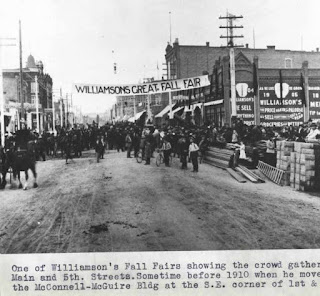Williamson's
By: EmilieRae Smith
Moscow was a growing and
bustling town in the late 1800s and early 1900s. There were multiple businesses
arising in downtown during the first decade of the twentieth century. These
buildings, modeled after Roman architecture[1], are now
part of Moscow's historic district. Commercial businesses started popping up as
early as 1881. Businesses really took off, however, after brick became more
accessible.
 |
| Williamson's Store - LCHS Photo Collection |
One of these prominent
businesses on Main Street was Williamson's. Nathaniel Williamson was an Irish
immigrant who originally set up shop on the 400 block of South Main in 1904. He
called his store The Greater Boston. His store featured flashy signage and
advertisements from the Great Boston Horse Show and Great Fall Fairs,[2] which was
uncommon during this time to have advertisements from events happening in the
Eastern United States. In 1913, he leased the McConnell-McGuire building, which
he turned into a department store selling furniture and clothes for men, women
and children. It was stocked with
imported European fabrics and was said to be the best merchandise in the new
western states by the Williamson's advertisements.
 |
| From LCHS archival collection |
Nathaniel Williamson held contests
during Christmas and had annual fairs for advertisement. The annual White Fair
was advertised as “the most powerful, most meritorious of any similar
occurrence in the inland empire.”[3] These White
Fairs featured sales for his store and prizes to be won. The fairs drew in
people from all over the Palouse and ran consecutively for fifteen years,
proving to be a success every time. The other tradition Williamson started was
during Christmas time. Every year, he'd put up a giant Christmas tree in the
McConnell-McGuire building and hold a contest for people to guess how tall the
tree was. There were prizes as well as big community gatherings.
 |
| From LCHS archival collection |
Williamson's was in business during the years leading up to
World War I and the very beginning of it. In its catalogs, there was wartime
propaganda for why the United States was going to join the war against Germany.
At the beginning of Williamson's catalogs, political poems were printed about
the strong and valiant United States and their efforts to take down the German
enemy.
As Williamson's prepared to close
his business, he advertised grand sales to liquidate his inventory. In one of their final catalogs, Williamson's
listed all they did to help the Moscow community. For example during the first
fifteen years of their business, they paid $769,800 in taxes, rent, salaries,
insurance and donations to Moscow.[4]
 |
| Interior view of Williamson's store - LCHS Photo Collection |
 |
| LCHS Photo Collection |
You should do an oral history with Tim Brown of Brown's Furniture. Tim's father ran the store in this building, you can see a painted sign on the south wall. Browns operated there for a number of years before building a new location on the south Moscow hill.
ReplyDelete